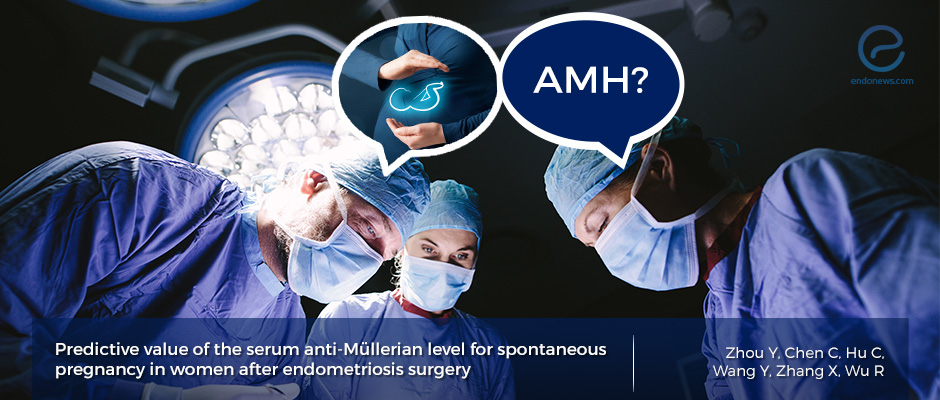Serum anti-Müllerian hormone levels for predicting spontaneous pregnancy after endometriosis surgery
Oct 25, 2019
Occurrence of spontaneous pregnancy in women after endometriosis surgery can be predicted by the preoperative serum anti-Müllerian hormone levels.
Key Points
Highlights:
- High serum anti-Müllerian hormone levels measured before the operation are associated with the high probability of natural pregnancy in women who underwent endometriosis surgery.
Importance:
- As a part of the fertility strategy, preoperative serum anti-Müllerian hormone levels can be used to predict the occurrence of spontaneous pregnancy in women seeking conception after endometriosis surgery.
What’s done here?
- This prospective cohort study examined 103 women who underwent surgery for suspected ovarian endometrioma and planned to get pregnant after surgery.
- Serum anti-Müllerian hormone (AMH) levels were measured on the third to fifth days of their spontaneous menstrual cycle pre- and postoperatively.
- The cut-off value of 2.0 ng/mL was used as a prognostic indicator for the in-vitro fertilization outcome. Women were divided into two groups regarding preoperative serum AMH levels.
- The decline of serum AMH levels between pre- and postoperative levels were calculated, and the rate of AMH decline was also assessed.
- All women who met the criteria were followed-up for 2 years after surgery and obstetric outcomes were recorded.
Key results:
- There were 61 patients in the high AMH group, while 42 patients were included in the low AMH group.
- There was no statistically significant difference between groups based on the patients’ age at surgery, body mass index, revised American Fertility Society stage, size of ovarian endometrioma, and laterality.
- Serum AMH levels significantly decreased postoperatively in both groups. This decline was more prominent in the low AMH group.
- After surgery, 52 women get pregnant spontaneously.
- The best prediction of spontaneous pregnancy after surgery could be achieved by preoperative AMH levels, the best threshold being the preoperative AMH level 3.545 ng/ml.
Limitations:
- Authors stated one limitation about the study that data analysis was limited in a small sample size.
Lay Summary
Endometriosis is a disease defined as the localization of endometrial glandular and stromal cells outside the uterine cavity. Although there are several medical and surgical therapeutic options, the most effective treatment modality has not yet been elucidated.
The main objective of surgical interventions should be therapeutic and effective. There is a relationship between endometriosis and reduced ovarian reserve, decreased pregnancy rates, fertility problems. Thus, total surgical removal of the disease is very important to prevent recurrence.
Ultrasonographic antral follicle count, serum follicle-stimulating hormone, estradiol and statin B can be used to assess ovarian reserve. Serum anti-Müllerian hormone (AMH) which is produced by the ovarian follicles is started to be used recently as a reliable ovarian reserve marker. Although the reduced ovarian reserve is encountered in most women with endometriosis, postoperative use of assisted reproduction techniques may not be necessary for all.
Zhou et al, a group of scientists from China, published a study titled “Predictive value of the serum anti-Müllerian level for spontaneous pregnancy in women after endometriosis surgery” in the journal named as "Journal of International Medical Research".
In this study, the authors aimed to assess spontaneous pregnancy outcomes using serum AMH levels after endometriosis surgery. They divided the study population depending on their serum AMH levels into two groups: low AMH group (≤2 ng/mL) and high AMH group (>2 ng/mL). When they compared these two groups, they found that serum AMH level was decreased in both groups postoperatively. However, this decline was more obvious in the low AMH group. The cumulative pregnancy rate was higher in the high AMH group.
The best prediction of postoperative spontaneous pregnancy was achieved by the preoperative serum AMH levels.
“Preoperative AMH level measurements can be used as part of a fertility strategy for women undergoing endometriosis surgery and seeking fertility assistance,” the authors added.
Research Source: https://www.ncbi.nlm.nih.gov/pubmed/31554444
endometriosis anti-Müllerian hormone cumulative pregnancy rate fertility ovarian cystectomy pregnancy outcome

